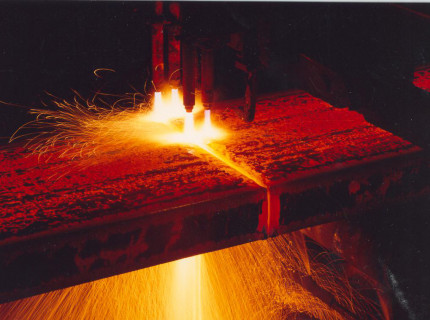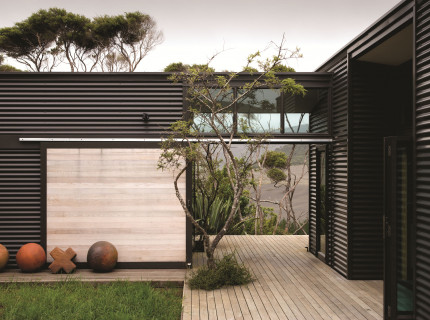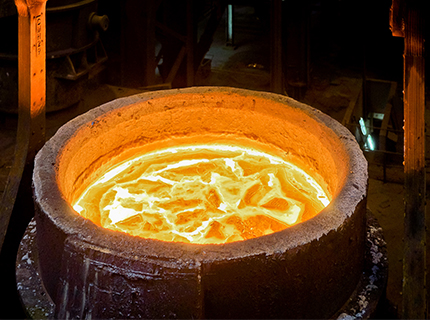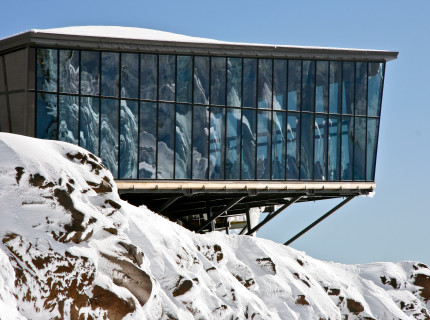To achieve maximum water conservation, water is cleaned, cooled and recirculated many times in each process. Some freshwater, however, must be added to the water circuits to maintain the required water quality. New Zealand Steel places importance on returning water used in this process to the environment in the best possible condition. The water that is released back into the environment undergoes various types of treatment, so that it will meet the high quality standards specified in the discharge permit, issued by the Auckland Council. To learn more about this, see the Monitoring Environmental Effects page.
Three types of wastewater need to be managed at the Glenbrook site.
These result from:
- Transporting ironsand concentrate
- The steelmaking and finishing processes
- Storm water collected from the industrial site
Water from Ironsand Slurry Transport
Around 7,000 cubic metres of water is used to transport the ironsand concentrate from the Waikato North Head mine to the Glenbrook mill, via an underground pipeline 18 kilometres long. Once the slurry arrives at the Glenbrook site the ironsand concentrate is separated from the water, which contains clay minerals as a result of the turbulent transport process. The clay minerals must be removed from the water before the water is discharged into the environment. A settling agent is added to the treatment process to help settle out the clay minerals. The cleaned water is drawn off and discharged to a nearby drain before discharging into the Waiuku Estuary.
As slurry water is extracted near the mouth of the Waikato River, it has periodically high chloride (salt) levels and so this water cannot be reused in the steelmaking process, as salt water damages metal pipework.
Wastewater from Mill Operations
Wastewater produced at the steel mill will contain either large quantities of solids - mainly iron oxides, coal dust, ash - or chemicals. With appropriate treatment 98% of the water is reused or recirculated.
Wastewater can be classified as:
- Cooling water
- Process water
- Water for solids conveyance
- Stormwater
Cooling Water
Water is used to cool the hot steel after it has been cast into slabs and as it is rolled into sheets. This water becomes contaminated with iron oxide scale, dust and other solids. After these solids have been removed by filters or in large settling basins, the water is recirculated. Cooling towers are used to lower the temperature of the water after it has been used to cool the hot steel. A lot of water evaporates in these towers which increases the concentration of naturally occurring salts in the water left behind. Fresh water is then added to dilute the dissolved salts in the cooling circuit water and about 1% of existing water is treated and then discharged.
Process Water
In the rolling and coating processes chemicals are added to water for treating or rinsing the steel. For example, caustic solutions are used in cleaning baths in the pipe mill and both caustic and chromic acid solutions are used in the coil coating and metal coating lines. These diluted chemicals will be reused several times before they are replaced. Treatment facilities ensure that any chemicals left in the process water are removed. Wastewater may also contain oil from the rolling and coating processes. A special oil wastewater treatment plant operates in the rolling mills to remove the oils from the water before recycling. Process wastewater will also contain some suspended solid particles and the water may be either acidic or caustic. Each water treatment facility at Glenbrook is designed to deal with this range of wastewater quality.
Water for Solids Conveyance
Water is used in the air pollution control systems, which clean the hot waste gases before they are discharged into the atmosphere. Water sprays collect the solids as the hot gases pass through various chambers and the resulting mix of water and solids flows from the chamber to a treatment facility. The collected solids from the air pollution control systems are mainly iron oxides, coal dust and ash. There will also be trace concentrations of dissolved metals. The treatment facilities neutralise any acidity in the wastewater, precipitate dissolved metals and remove suspended solids. The water can then be recirculated again and the solids are deposited into the site landfill. All wastewater discharged to the Waiuku Estuary passes through the final wastewater treatment plants and over half will also pass through final treatment ponds. One of the wastewater treatment plants treats the wastewater to such a high standard it can be discharged directly. As the wastewater enters this treatment facility either lime or caustic soda is added to adjust the acidity. The wastewater then flows to a settling basin, where a chemical coagulant is added so that any solids congeal and sink to the bottom. Then it passes through cooling towers to reduce the water temperature. A special feature of the final treatment plant is the use of sand filters which ensure maximum possible removal of solids from the wastewater. This wastewater can then be discharged directly to the Waiuku Estuary in accordance with the discharge permit.
Stormwater Water
Water that falls on the ground and buildings as rain is known as stormwater. Generally, stormwater will collect solid material as it flows over roads, through yards and stockpile areas and off buildings. All stormwater on the Glenbrook site is captured in large settling ponds to enable these solids to be removed from the water. As stormwater passes through the settling ponds the solid material will settle out and the water is clean enough to discharge into the Waiuku Estuary, or to be recycled back into the site water circuits.
Chemical Dosing of Water Circuits
Because of the high level of water recirculation at the Glenbrook Steel Mill, it is necessary to chemically dose certain water systems to prevent the formation or growth of corrosion products, scale, bacteria and algae. Chlorine is used to prevent algae growth and a range of inhibitors are used in water circuits to prevent corrosion. The chemicals used in the water circuits to assist with these problems are carefully selected, to ensure that the discharge water quality will be maintained at all times.
Exploring Alternative Water Supplies
New Zealand Steel has undertaken extensive research into the possibility of obtaining water from other sources. However, the studies showed that none of the proposed options would be able to be successfully implemented and would result in greater adverse environmental effects than the current abstraction of Waikato River water. Alternatives considered were -
Ground Water
In the early days of the steel mill groundwater was the only source of water for the Glenbrook operations. With the expansion of operations in the 1980s it was recognised that it was not feasible to maintain this water source, due to the high demand on ground water from local agriculture and the large volume of water required for the Mill. Prior to the expansion, around 6,000 tonnes each day was extracted from groundwater - the mill currently requires typically 20,000 tonnes of fresh water each day.
Sea Water
Using sea water would be a prohibitively costly option. The equipment currently used in the mining and production plants is not designed to withstand the severe corrosive conditions created by sea water and therefore would need to be replaced at considerable cost. Using salt water would also contaminate the ironsand concentrate so that greater quantities of fresh water would be required to wash the salt laden concentrate before it could be processed. This would use more water and therefore is contrary to the objectives of utilising an alternative water source.
Desalinated Sea Water
This is another alternative but one that would have significant adverse effects on the environment. A desalination plant would use large areas of land for the processing plant, there would be a significant increase in energy use and subsequent increase of greenhouse gas emissions. As well, additional construction and operating costs would be such that New Zealand Steel could not remain competitive in the world steel market - with a capital cost of around $100 million. Although alternative water sources may not be feasible for New Zealand Steel activities, the company is committed to water conservation.



